INTERNATIONAL
STANDARD
ISO/IEC
14496-15
First edition
2004-04-15
Information technology — Coding of
audio-visual objects —
Part 15:
Advanced Video Coding (AVC) file format
Technologies de l'information — Codage des objets audiovisuels —
Partie 15: Format de fichier de codage vidéo avancé (AVC)
Reference number
ISO/IEC 14496-15:2004(E)
�
ISO/IEC 14496-15:2004(E)
ii
�
ISO/IEC 14496-15:2004(E)
Contents
Page
Foreword ............................................................................................................................................................ iv
Introduction ........................................................................................................................................................ v
1
2
3
3.1
3.2
Scope...................................................................................................................................................... 1
Normative references ........................................................................................................................... 1
Terms, definitions, symbols and abbreviated terms ......................................................................... 1
Terms and definitions........................................................................................................................... 1
Symbols and abbreviated terms.......................................................................................................... 2
Extensions to the ISO Base Media File Format.................................................................................. 2
4
Introduction ........................................................................................................................................... 2
4.1
File identification................................................................................................................................... 2
4.2
Independent and Disposable Samples Box ....................................................................................... 2
4.3
Sample groups ...................................................................................................................................... 3
4.4
4.4.1
Introduction ........................................................................................................................................... 3
4.4.2 SampleToGroup Box ............................................................................................................................ 4
4.4.3 SampleGroupDescription Box ............................................................................................................. 5
4.5
Random access recovery points ......................................................................................................... 6
4.5.1 Syntax..................................................................................................................................................... 6
4.5.2 Semantics .............................................................................................................................................. 6
4.6
Representation of new structures in movie fragments..................................................................... 7
AVC elementary streams and sample definitions ............................................................................. 7
5
Elementary stream structure ............................................................................................................... 7
5.1
Sample and Configuration definition .................................................................................................. 9
5.2
5.2.1
Introduction ........................................................................................................................................... 9
5.2.2 Canonical order and restrictions......................................................................................................... 9
5.2.3 AVC sample structure definition ....................................................................................................... 11
5.2.4 Decoder configuration information ................................................................................................... 11
Derivation from ISO Base Media File Format ................................................................................... 13
5.3
5.3.1
Introduction ......................................................................................................................................... 13
5.3.2 AVC File type and identification ........................................................................................................ 13
5.3.3 AVC Track Structure ........................................................................................................................... 13
5.3.4 AVC Video Stream Definition ............................................................................................................. 13
5.3.5 AVC parameter set stream definition................................................................................................ 15
5.3.6 Template fields used........................................................................................................................... 16
5.3.7 Visual width and height ...................................................................................................................... 16
5.3.8 Parameter sets .................................................................................................................................... 17
5.3.9 Decoding time (DTS) and composition time (CTS).......................................................................... 17
5.3.10 Sync sample (IDR)............................................................................................................................... 17
5.3.11 Shadow sync ....................................................................................................................................... 17
5.3.12 Layering and sub-sequences ............................................................................................................ 18
5.3.13 Alternate streams and switching pictures........................................................................................ 21
5.3.14 Random access recovery points ....................................................................................................... 23
5.3.15 Hinting .................................................................................................................................................. 23
iii
�
ISO/IEC 14496-15:2004(E)
Foreword
ISO (the International Organization for Standardization) and IEC (the International Electrotechnical
Commission) form the specialized system for worldwide standardization. National bodies that are members of
ISO or IEC participate in the development of International Standards through technical committees
established by the respective organization to deal with particular fields of technical activity. ISO and IEC
technical committees collaborate in fields of mutual interest. Other international organizations, governmental
and non-governmental, in liaison with ISO and IEC, also take part in the work. In the field of information
technology, ISO and IEC have established a joint technical committee, ISO/IEC JTC 1.
International Standards are drafted in accordance with the rules given in the ISO/IEC Directives, Part 2.
The main task of the joint technical committee is to prepare International Standards. Draft International
Standards adopted by the joint technical committee are circulated to national bodies for voting. Publication as
an International Standard requires approval by at least 75 % of the national bodies casting a vote.
Attention is drawn to the possibility that some of the elements of this document may be the subject of patent
rights. ISO and IEC shall not be held responsible for identifying any or all such patent rights.
ISO/IEC 14496-15 was prepared by Joint Technical Committee ISO/IEC JTC 1, Information technology,
Subcommittee SC 29, Coding of audio, picture, multimedia and hypermedia information.
ISO/IEC 14496 consists of the following parts, under the general title Information technology — Coding of
audio-visual objects:
Part 1: Systems
Part 2: Visual
Part 3: Audio
Part 4: Conformance testing
Part 5: Reference software
Part 6: Delivery Multimedia Integration Framework (DMIF)
Part 7: Optimized reference software for coding of audio-visual objects [Technical Report]
Part 8: Carriage of ISO/IEC 14496 contents over IP networks
Part 9: Reference hardware description [Technical Report]
Part 10: Advanced Video Coding
Part 11: Scene description and application engine
Part 12: ISO base media file format
Part 13: Intellectual Property Management and Protection (IPMP) extensions
Part 14: MP4 file format
Part 15: Advanced Video Coding (AVC) file format
Part 16: Animation Framework eXtension (AFX)
Part 17: Streaming text format
Part 18: Font compression and streaming
Part 19: Synthesized texture stream
iv
�
ISO/IEC 14496-15:2004(E)
Introduction
The Advanced Video Coding (AVC) standard, jointly developed by the ITU-T and ISO/IEC SC29/WG11
(MPEG), offers not only increased coding efficiency and enhanced robustness, but also many features for the
systems that use it. To enable the best visibility of, and access to, those features, and to enhance the
opportunities for the interchange and interoperability of media, this part of ISO/IEC 14496 defines a storage
format for video streams compressed using AVC.
This part of ISO/IEC 14496 defines a storage format based on, and compatible with, the ISO Base Media File
Format (ISO/IEC 14496-12 and ISO/IEC 15444-12), which is used by the MP4 file format (ISO/IEC 14496-14)
and the Motion JPEG 2000 file format (ISO/IEC 15444-3) among others. This part of ISO/IEC 14496 enables
AVC video streams to:
be used in conjunction with other media streams, such as audio;
be used in an MPEG-4 systems environment, if desired;
be formatted for delivery by a streaming server, using hint tracks;
inherit all the use cases and features of the ISO Base Media File Format on which MP4 and MJ2 are
based.
This part of ISO/IEC 14496 may be used as a standalone specification; it specifies how AVC content shall be
stored in an ISO Base Media File Format compliant format. However, it is normally used in the context of a
specification, such as the MP4 file format, derived from the ISO Base Media File Format, that permits the use
of AVC video.
The ISO Base Media File Format is becoming increasingly common as a general-purpose media container
format for the exchange of digital media, and its use in this context should accelerate both adoption and
interoperability.
Extensions to the ISO Base Media File Format are defined here to support the new systems aspects of the
AVC codec.
v
�
ISO/IEC 14496-15:2004(E)
�
INTERNATIONAL STANDARD
ISO/IEC 14496-15:2004(E)
Information technology — Coding of audio-visual objects —
Part 15:
Advanced Video Coding (AVC) file format
1 Scope
This part of ISO/IEC 14496 specifies the storage format for AVC (ISO/IEC 14496-10 | ITU-T Rec. H.264)
video streams.
The storage of AVC content uses the existing capabilities of the ISO Base Media File Format but also defines
extensions to support the following features of the AVC codec:
Switching pictures: To enable switching between different coded streams and substitution of pictures
within the same stream.
Sub-sequences and layers: Provides a structuring of the dependencies of a group of pictures to
provide for a flexible stream structure (e.g. in terms of temporal scalability and layering).
Parameter sets: The sequence and picture parameter set mechanism decouples the transmission of
infrequently changing information from the transmission of coded macroblock data. Each slice
containing the coded macroblock data references the picture parameter set containing its decoding
parameters. In turn, the picture parameter set references a sequence parameter set that contains
sequence level decoding parameter information.
2 Normative references
The following referenced documents are indispensable for the application of this document. For dated
references, only the edition cited applies. For undated references, the latest edition of the referenced
document (including any amendments) applies.
ISO/IEC 14496-1:2001, Information technology — Coding of audio-visual objects — Part 1: Systems
ISO/IEC 14496-10, Information technology — Coding of audio-visual objects — Part 10: Advanced video
coding | ITU-T Rec. H.264, Advanced video coding for generic audiovisual services
ISO/IEC 14496-12, Information technology — Coding of audio-visual objects — Part 12: ISO base media file
format (technically identical to ISO/IEC 15444-12)
3 Terms, definitions, symbols and abbreviated terms
3.1 Terms and definitions
the purposes of
For
ISO/IEC 14496-10 | ITU-T Rec. H.264 and the following apply.
terms and definitions given
this document,
the
in
ISO/IEC 14496-1,
1
�
ISO/IEC 14496-15:2004(E)
3.1.1
parameter set
a sequence parameter set or a picture parameter set, as defined in ISO/IEC 14496-10
NOTE
This term is used to refer to both types of parameter sets.
3.1.2
parameter set elementary stream
elementary stream containing samples made up of only sequence and picture parameter set NAL units
synchronized with the video elementary stream
3.1.3
video elementary stream
elementary stream containing access units made up of NAL units for coded picture data
3.2 Symbols and abbreviated terms
AVC
HRD
IDR
NAL
PPS
SEI
SPS
Advanced Video Coding [ISO/IEC 14496-10]
Hypothetical Reference Decoder
Instantaneous Decoding Refresh
Network Abstraction Layer
Picture Parameter Set
Supplementary Enhancement Information
Sequence Parameter Set
4 Extensions to the ISO Base Media File Format
4.1
Introduction
This clause documents technical additions to the ISO Base Media File Format, which can be used when
storing AVC streams. However, these additions could also be used by other media, if they are defined to use
them. They are therefore documented here separately.
4.2 File identification
The brand ‘avc1’ shall be used to indicate that extensions conformant with this section are used in a file. The
use of ‘avc1’ as a major-brand may be permitted by specifications; in that case, that specification defines the
file extension and required behaviour.
4.3
Independent and Disposable Samples Box
‘sdtp’
Box Types:
Container: Sample Table Box (‘stbl’)
Mandatory: No
Quantity:
Exactly one
This optional table answers three questions about sample dependency:
1) Does this sample depend on others (is it an I-picture)?
2) Do no other samples depend on this one?
3) Does this sample contain multiple (redundant) encodings of the data at this time-instant (possibly
with different dependencies)?
2
�
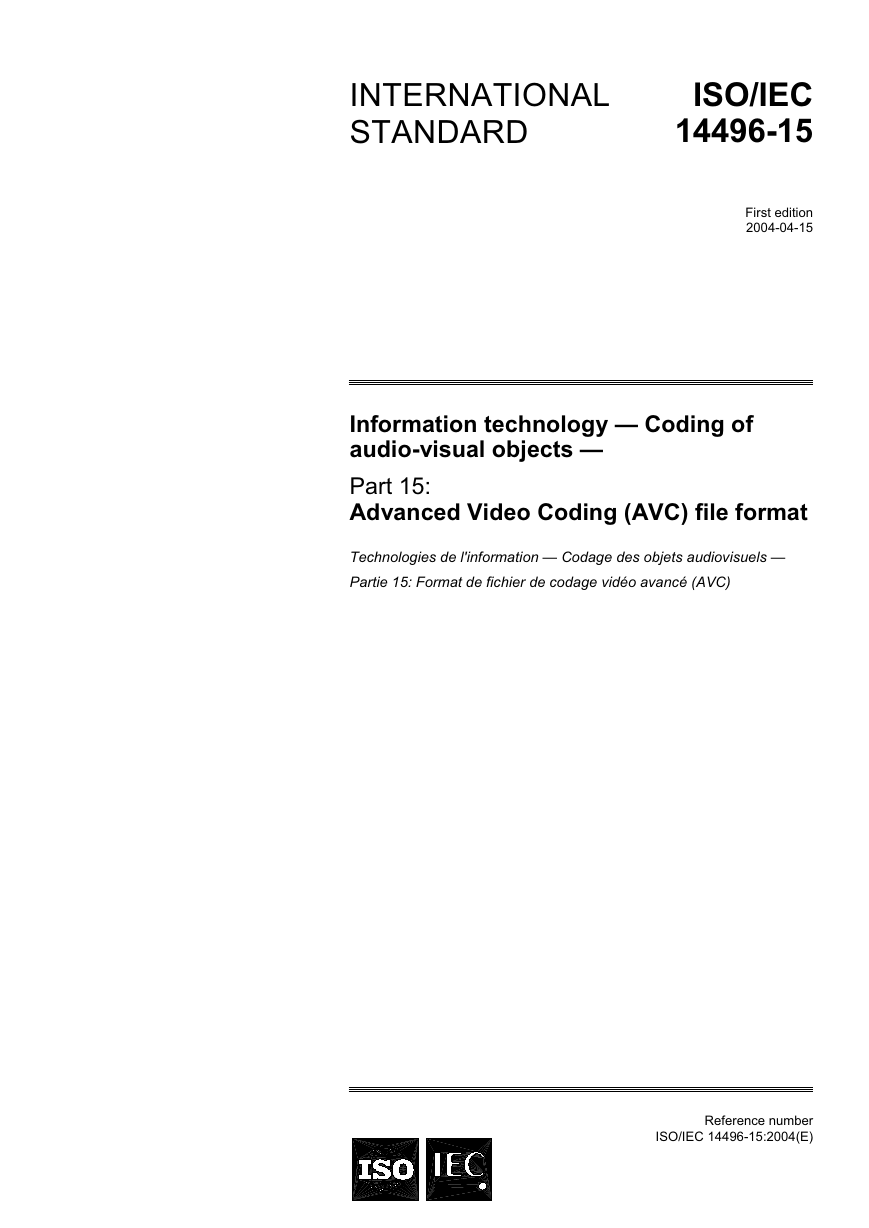


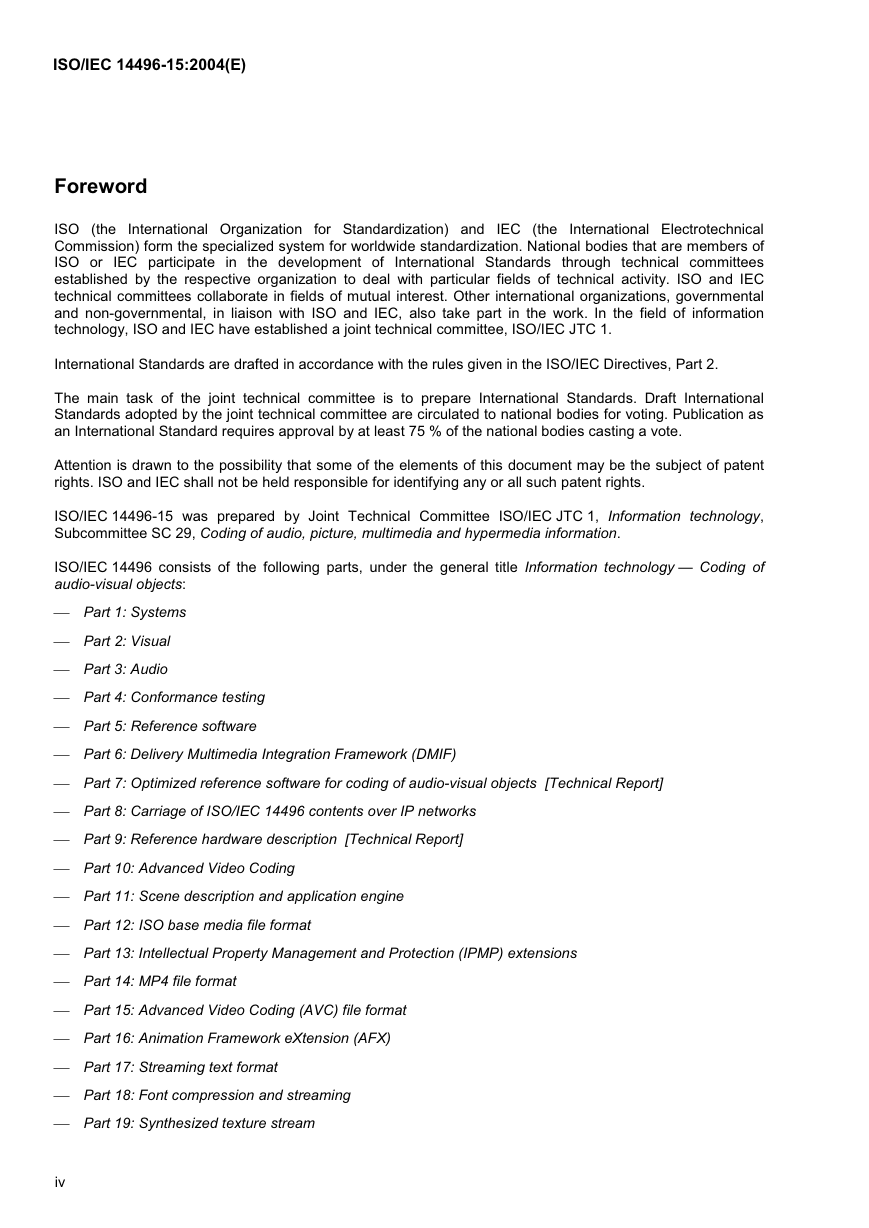
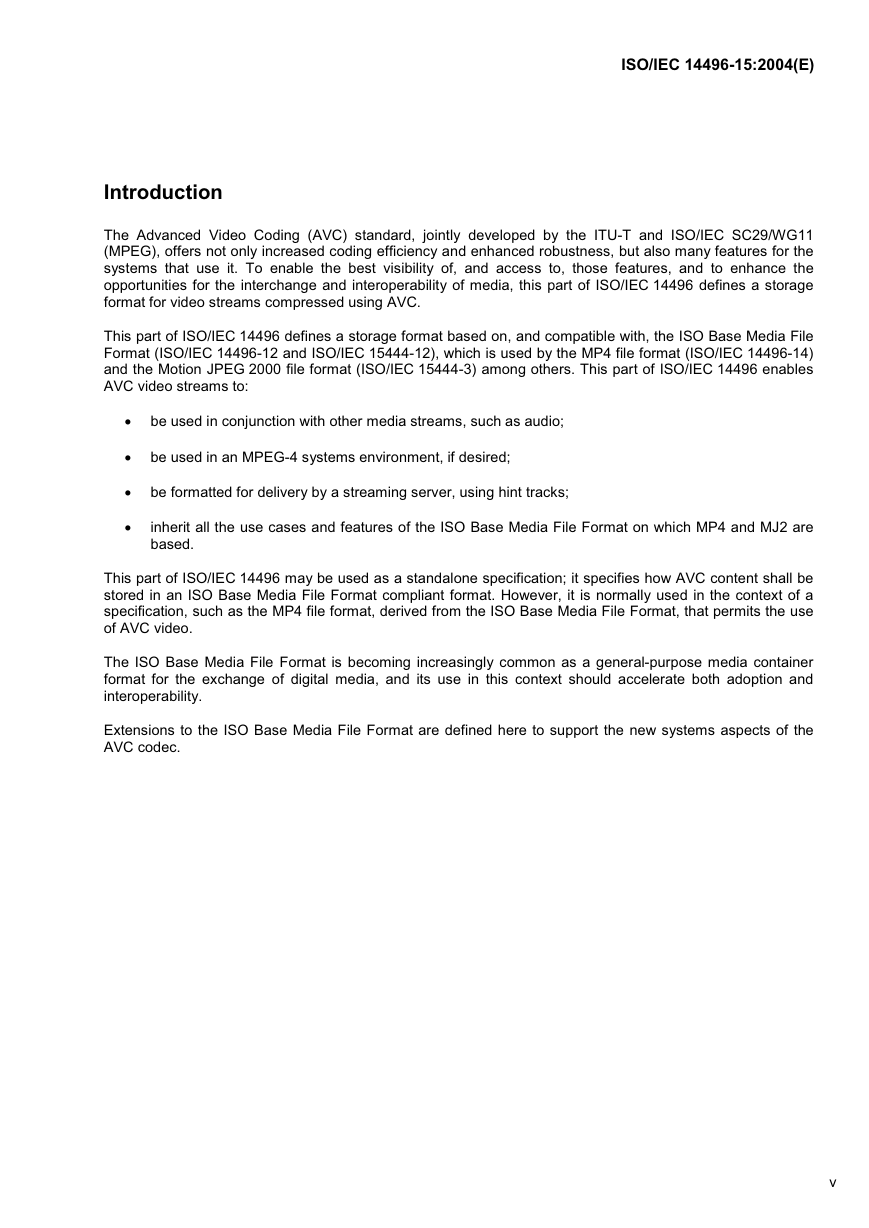

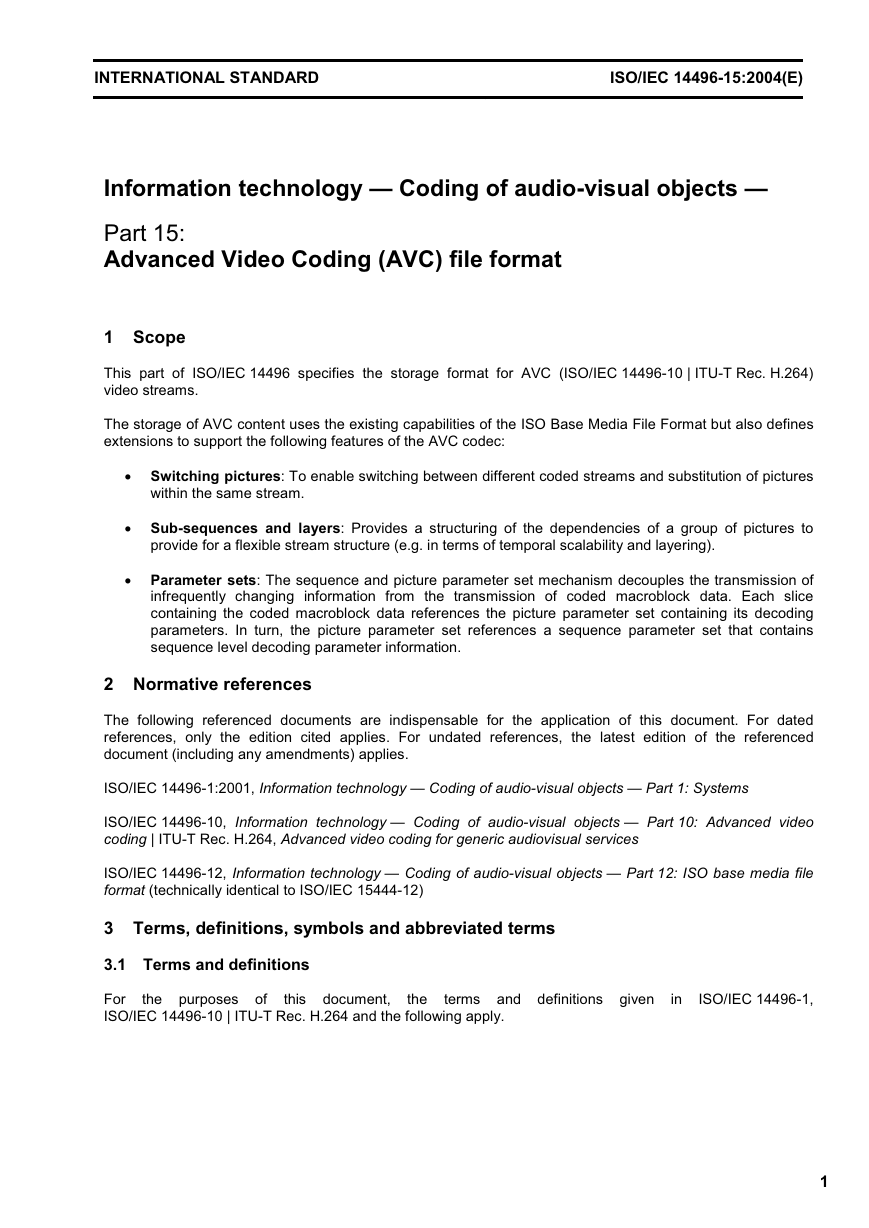
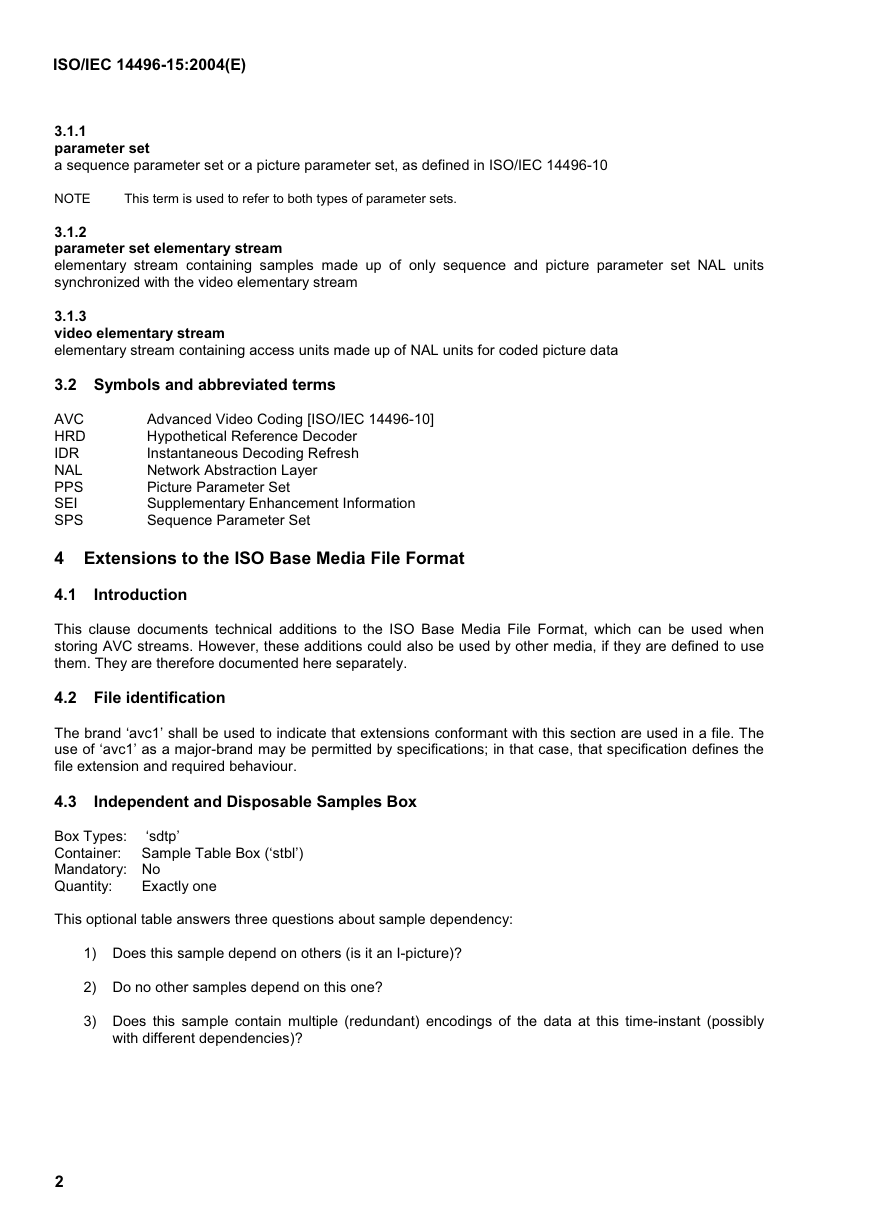








 2023年江西萍乡中考道德与法治真题及答案.doc
2023年江西萍乡中考道德与法治真题及答案.doc 2012年重庆南川中考生物真题及答案.doc
2012年重庆南川中考生物真题及答案.doc 2013年江西师范大学地理学综合及文艺理论基础考研真题.doc
2013年江西师范大学地理学综合及文艺理论基础考研真题.doc 2020年四川甘孜小升初语文真题及答案I卷.doc
2020年四川甘孜小升初语文真题及答案I卷.doc 2020年注册岩土工程师专业基础考试真题及答案.doc
2020年注册岩土工程师专业基础考试真题及答案.doc 2023-2024学年福建省厦门市九年级上学期数学月考试题及答案.doc
2023-2024学年福建省厦门市九年级上学期数学月考试题及答案.doc 2021-2022学年辽宁省沈阳市大东区九年级上学期语文期末试题及答案.doc
2021-2022学年辽宁省沈阳市大东区九年级上学期语文期末试题及答案.doc 2022-2023学年北京东城区初三第一学期物理期末试卷及答案.doc
2022-2023学年北京东城区初三第一学期物理期末试卷及答案.doc 2018上半年江西教师资格初中地理学科知识与教学能力真题及答案.doc
2018上半年江西教师资格初中地理学科知识与教学能力真题及答案.doc 2012年河北国家公务员申论考试真题及答案-省级.doc
2012年河北国家公务员申论考试真题及答案-省级.doc 2020-2021学年江苏省扬州市江都区邵樊片九年级上学期数学第一次质量检测试题及答案.doc
2020-2021学年江苏省扬州市江都区邵樊片九年级上学期数学第一次质量检测试题及答案.doc 2022下半年黑龙江教师资格证中学综合素质真题及答案.doc
2022下半年黑龙江教师资格证中学综合素质真题及答案.doc